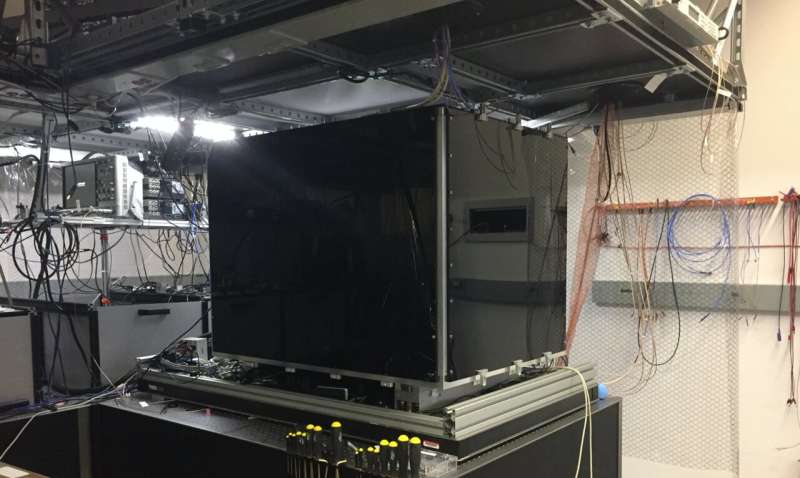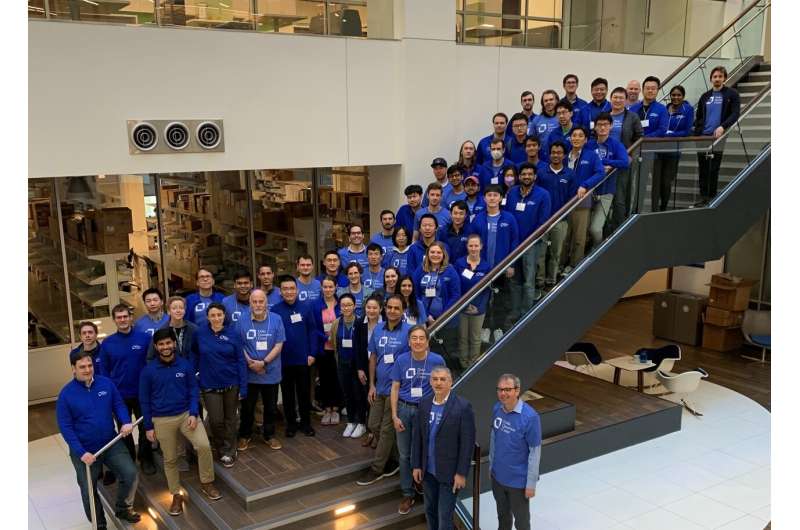The quantum computer used in this study at University of Maryland. Credit: Noel et al
Trapped-ion quantum computers are quantum devices in which trapped ions vibrate together and are fully isolated from the external environment. These computers can be particularly useful for investigating and realizing various quantum physics states.
Researchers at NIST/University of Maryland and Duke University have recently used a trapped-ion quantum computer to realize two measurement-induced quantum phases, namely the pure phase and mixed or coding phase during a purification phase transition. Their findings, published in a paper in Nature Physics, contribute to the experimental understanding of many-body quantum systems.
"Our methods were based on work by Michael Gullans and David Huse, which identified a measurement-induced purification transition in random quantum circuits," Crystal Noel, one of the researchers who carried out the study, told Phys.org. "The main objective of our paper was to observe this critical phenomenon experimentally, using a quantum computer."
To measure the purification phase transition first outlined by Gullans and Huse, the researchers had to average data collected over several random circuits. In addition, the measurements they collected included both unitary and projective measurements.
"By starting in a mixed state with high entropy, or information, then evolving the circuits, the entropy at the end of the circuit indicates whether that information has been lost, or in other words the system has purified," Noel explained. "We measured the entropy of the system after the circuit evolution as we tune the rate of measurement across the transition."
According to theoretical predictions, the purification phase transition probed by the team should have emerged at a critical point, resembling a fault-tolerant threshold. Noel and her colleagues carried out their experiments on random circuits that were optimized to work well with their ion-trap quantum computer. This allowed them to observe the different phases of purification using a relatively small system.
"Critical phenomena of this nature are difficult to observe due to the need for large system sizes, mid-circuit measurement, and averaging over many random circuits taking significant computation time," Noel said. "We found a way to tailor the model we studied to the system we had available, and show that with a minimal model, the critical phenomena can still be observed."
Using their trapped-ion quantum computer, the team was able to probe both the pure phase of the purification phase transition and the mixed or coding phase. In the first of these states, the system is rapidly projected to a pure state, which is related to the measurement outcomes. In the second, the system's initial state is partly encoded into a quantum error correcting coding space, which retains the system's memory of its original conditions for a longer time.
The new Duke Quantum Center team. Credit: Noel et al
Noel and her colleagues' successful realization of these two phases of the purification transition in their ion-trap quantum computer could inspire other teams to use similar systems to probe other quantum phases of matter. In their next work, the researchers will continue using the same computer, which has now been moved to the New Duke Quantum Center, to investigate other physical phenomena. Chris Monroe, the principal investigator on the recent study, is now Director of this Center, and will be leading further studies works using the trapped-ion quantum computer.
"We now plan to continue to study critical phenomena in random circuits using our trapped ion quantum computer. We will add more qubits and mid-circuit measurement to increase the hardware capabilities. We will work to find new observables and interesting transitions that are similar to the one observed here in order to understand more about quantum computing and open quantum systems more generally."
More information: Crystal Noel et al, Measurement-induced quantum phases realized in a trapped-ion quantum computer, Nature Physics (2022). DOI: 10.1038/s41567-022-01619-7
Journal information: Nature Physics
© 2022 Science X Network

























